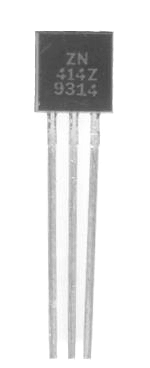ZN414

The original ZN414 chip from Ferranti was supplied in a 3-pin, metal TO-18 'transistor' package whereas the GEC part and later Ferranti ones (ZN414Z) used the plastic TO-92 encapsulation. Later variants, the ZN415 and ZN416, came in 8-pin DIL packages and included a built-in amplifier that could drive headphones and small speakers directly.
The radio circuit inside the ZN414 was based on a design known as Tuned Radio Frequency (TRF). The TRF design is much simpler than the popular, but more complex, superheterodyne radio circuit often used in modern AM receivers. It was principally the use of the TRF circuit that allowed almost a whole radio to be fitted into one small, three pin package.

The manufacturing process for the ZN414 chip used a relatively new (for the time) technique known as Collector Diffusion Isolation (CDI). CDI was invented by engineers at Bell Telephone Laboratories and subsequently developed into a commercial process by Ferranti in the UK.[1]
The original ZN41x family have not been manufactured for some time, but modern equivalents to the original 3-pin ZN414 are available, with part codes of MK484, TA7642 and (mainly in India, the Far East & Australasia) YS414 and LMF501T. Note that on the YS414 part, pins 1 (output) and 3 (ground/earth) are transposed.

Notes
External links
| Wikimedia Commons has media related to ZN414. |
- ZN414Z/415E/416E datasheet
- MK484 datasheet
- TA7642 datasheet
- LMF501T datasheet
- Web site with examples of some matchbox radios based on the ZN414Z
- Another ZN414 radio
- A MK484 radio
- Ferranti Electronics ZN414Z/ZN415E/ZN416E datasheet reprint by Jaycar Electronics